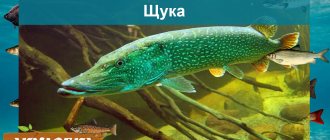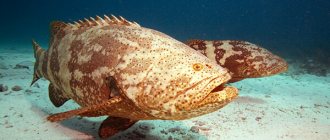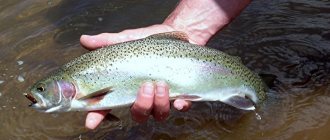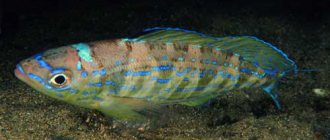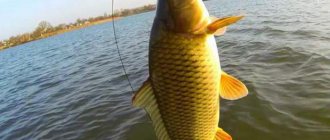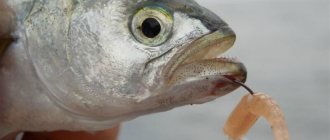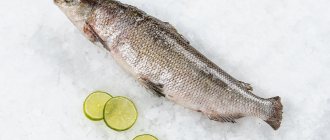- Wild animals
- >>
- Fish
Marlin is a species of large, long-nosed marine fish characterized by an elongated body, a long dorsal fin, and a rounded snout extending from the snout. They are wanderers found around the world near the surface of the sea and are carnivores that feed primarily on other fish. They are consumed as food and are highly prized by sport fishermen.
Origin of the species and description
Photo: Marlin
Marlin is a member of the billfish family, a group of perciformes.
There are usually four main types of marlin mentioned:
- Blue marlin, found throughout the world, is a very large fish, sometimes weighing 450 kg or more. It is a dark blue member of the animal kingdom with a silver belly and often lighter vertical stripes. Blue marlin tend to dive deeper and tire more quickly than other marlin;
- the black marlin becomes as huge or even larger than the blue marlin. It is known to reach a weight of over 700 kg. The Indo-Pacific species is blue or light blue, gray above and lighter below. Its distinctive rigid pectoral fins are angled and cannot be flattened into the body without force;
- Striped marlin, another Indo-Pacific fish, is bluish above and white below with pale vertical stripes. Usually it does not exceed 125 kg. Striped marlin are renowned for their fighting ability and have a reputation for spending more time in the air than in the water once hooked. They are known for long runs and tail walks;
- white marlin (M. albida or T. albidus) is restricted to the Atlantic and is blue-green in color with a lighter belly and pale vertical stripes on its sides. Its maximum weight is about 45 kg. White marlin, despite the fact that they are the smallest species of marlin, weighing no more than 100 kg, are in demand due to their speed, elegant jumping ability and the difficulty of baiting and fishing them.
Marlin diet
All marlins are predatory aquatic creatures. For example, black marlin feed on a variety of pelagic fish and also prey on squid and crustaceans. In the waters of Malaysia, the main diet of this species consists of anchovies, various species of horse mackerel, flying fish and squid.
Sailfish feed on small fish that live in the upper layers of the water, including sardines, anchovies, mackerel and mackerel. The diet of this species also includes crustaceans and cephalopods. The larval stage of the Atlantic blue marlin, or blue marlin, feeds on zooplankton, including planktonic eggs and the larvae of other fish species. Adults hunt fish, including mackerel, as well as squid. Near coral reefs and ocean islands, blue marlin feed on the juveniles of various coastal fish.
Lesser or Western Atlantic spearfish feed in the upper water layers on squid and fish, but the composition of the diet of this species is quite diverse. In the southern parts of the Caribbean, small spearfish eat Ommastrephidae, herring and Mediterranean tarsier. In the western Atlantic, the main food organisms are Atlantic sea bream, snake mackerel and cephalopods, including Ornithoteuthis antillarum, Hyaloteuthis relagaica and Tremostorus violaceus.
Spearfish, living in the northern subtropics and tropics of the Atlantic Ocean, prefer fish and cephalopods. In the gastric contents of such marlins, fish were found that belong to twelve families, including hempylidae (Gempylidae), flying fish (Exocoetidae) and mackerel (Scombridae), as well as sea bream (Bramidae).
Return to content
Appearance and features
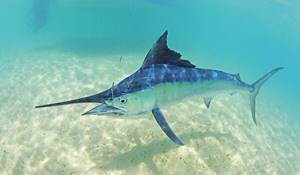
Photo: What marlin looks like
The signs of a blue marlin are as follows:
- a pointed anterior dorsal fin that never reaches its maximum body depth;
- the pectoral (lateral) fins are not rigid, but can be folded back towards the body;
- a cobalt blue back that fades to white. The animal has pale blue stripes that always disappear after death;
- the general shape of the body is cylindrical.
Fun fact: Black marlin are sometimes called the "bull of the sea" due to their extreme strength, large size, and incredible endurance when hooked. All this obviously makes them a very popular fish. They may sometimes have a silvery haze covering their body, meaning they are sometimes called "silver marlin".
Video: Marlin
Signs of a black marlin:
- low dorsal fin relative to body depth (smaller than most marlin);
- the beak and body are shorter than those of other species;
- the dark blue back fades to a silver belly;
- rigid pectoral fins that cannot fold.
White marlin are easy to spot. Here's what to look for:
- the dorsal fin is rounded, often exceeding the depth of the body;
- lighter, sometimes green color;
- spots on the belly, as well as on the dorsal and anal fins.
The characteristic features of striped marlin are as follows:
- a pointed dorsal fin that may extend above its body depth;
- light blue stripes are visible that remain even after death;
- thinner, more compressed body shape;
- flexible pointed pectoral fins.
Types of marlin
All species of marlin have an elongated body shape, as well as a characteristic spear-shaped snout and a long, very rigid dorsal fin:
- Indo-Pacific sailfish (Istiоhorus platetyрterus) from the genus Swallowtails (Istiоhorus). The main distinctive feature of the sailfish is the high and long first dorsal fin, resembling a sail, starting from the occipital part and running almost along the entire back of the fish. The back is black with a blue tint, and the sides are brown with a blue tint. The belly area is silvery-white. On the sides there are a large number of not too large pale blue spots. The length of one-year-old individuals is a couple of meters, and adult fish are about three meters long and weigh one hundred kilograms;
- Black marlin (Istiommax indica) from the genus Istiommax belongs to the category of commercial fish, but the volume of world catches is no more than several thousand tons. A popular object of sport fishing has an elongated, but not too laterally compressed body, covered with elongated, dense and thick scales. The dorsal fins are separated by a small gap, and the caudal fin is characterized by a month-shaped shape. The back is dark blue, and the sides and belly area are silvery-white. Adults do not have stripes or spots on their body. The length of an adult fish is 460-465 cm with a body weight of up to 740-750 kg;
- Western Atlantic or small spearman (Tetrаturus pfluеgen) from the genus Spearmen (Tetraрturus). Fish of this species are distinguished by a powerful, elongated body, strongly flattened laterally, and also have an elongated and thin, spear-shaped snout, rounded in cross section. The pelvic fins are quite thin, equal to or slightly longer than the pectoral fins, retracted inside a deep groove on the belly. The back is dark in color with a blue tint, and the sides are silvery-white with random brown spots. The belly area is silvery-white. The maximum length of an adult is 250-254 cm, and body weight does not exceed 56-58 kg.
According to the classification, the species represented by the Short-nosed spearfish, or short-nosed marlin, or short-nosed spearfish (Tetrаturus аngustirostris), the Mediterranean spearfish, or the Mediterranean marlin (Tetraрturus belonе), the South European spearfish, or the North African spearfish (Tetraрturus georgii) are also known.
Atlantic white marlin, or Atlantic white marlin (Kajikia albidus), Striped spearfish, or striped marlin (Kajikia audax), as well as Indo-Pacific blue marlin (Makaira mazara), Atlantic blue marlin, or blue marlin (Makaira nigricans) and Atlantic sailfish (Istiоhorus albiсans).
Return to content
Where do marlin live?
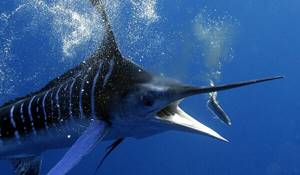
Photo: Marlin in the Atlantic Ocean
Blue marlin are pelagic fish, but they are rarely found in ocean waters less than 100 meters deep. Compared to other marlins, blues have the most tropical distribution. They can be found in the eastern and western waters of Australia and, depending on warm ocean currents, as far south as Tasmania. Blue marlin can be found in the Pacific and Atlantic oceans. Some experts believe that blue marlin, found in the Pacific and Atlantic oceans, are two different species, although this view is disputed. This seems to be because marlin in the Pacific tend to be larger than those in the Atlantic.
Black marlin typically live in the tropical Indian and Pacific oceans. They swim in coastal waters and around reefs and islands, but also roam the open sea. Very rarely they come to temperate waters, sometimes traveling around the Cape of Good Hope into the Atlantic.
White marlin live in tropical and seasonally temperate Atlantic waters, including the Gulf of Mexico, Caribbean Sea and Western Mediterranean. They can often be found in relatively shallow water close to shore.
Striped marlin is found in tropical and temperate waters of the Pacific and Indian oceans. Striped marlin is a highly migratory pelagic species found at depths of 289 meters. They are rarely seen in coastal waters except when there are sharp drops into deeper waters. Striped marlin are mostly solitary, but during the spawning season they form small groups. They hunt prey in surface waters at night.
Now you know where marlin lives. Let's see what this fish eats.
Marlin fish: description
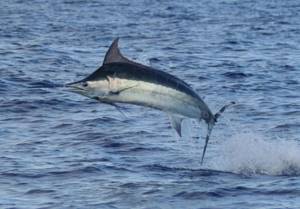
Two centuries ago, French ichthyologist Bernard Lacepède described this species using a drawing of this fish. After this, marlin fish began to be assigned various species and generic names.
Currently, marlin has one name, recognized by all experts, “Makaira nigricans”, which translated from Greek means “Short Dagger”.
Appearance

The most popular is the Blue Marlin or Atlantic Blue Marlin. The size of adult females is four times the size of adult males. As a rule, the mass of adult males is about 150 kg, while the mass of females is at the level of half a ton, with a body length of up to 5 meters. The distance from the eyes to the tip of the spear is approximately one-fifth of the marlin's total body size. It is known that this fish had a record weight of 636 kilograms.
Important information! Blue marlin is distinguished by the presence of two dorsal and two anal fins, the basis of which is made up of bony rays. In the first dorsal fin there are on average up to 40 rays, and in the second there are much fewer of them, only 6-7 rays.
The first anal fin is shaped like the second dorsal fin and consists of 15 rays. The pelvic fins are relatively narrow and long, and they can be retracted into special recesses located on the sides of the fish’s body. The pectoral fins are somewhat shorter than the pelvic fins, but they do not have a very developed membrane, and a depression can be seen inside the ventral groove.
The dorsal region of the Atlantic blue marlin is characterized by a dark blue color, and the sides are light, in silver tones. On the body you can also see several rows (more than 10) of stripes that have a greenish-blue tint. At the same time, they can be diluted with round dots and thinner stripes. The first dorsal fin is dark blue or almost black, without any inclusions of dots or stripes. Other fins are painted in lighter colors. There is a silver tint at the base of the anal fins.
The marlin's body is covered with thin but elongated scales. The spear is long and strong, and small teeth, similar to the serrations of a file, grow on the lower and upper jaws.
Interesting fact! During the hunt, marlins quickly change their color to a bright blue hue. This is possible thanks to substances such as iridophores, which contain pigments, and also thanks to special light-reflecting cells.
Thanks to the sensitive lateral line, the fish detects all movements in the water and also senses changes in atmospheric pressure. Behind the first anal fin is the anus. The blue marlin has twenty-four vertebrae.
Character and lifestyle

Marlin fish generally prefer to stay close to the surface of the water and away from the shoreline. When moving, this fish can swim at considerable speed, and often jumps out of the water several meters in height. If you take a sailfish, it can easily accelerate to a speed of 100 km/h, or even more. Therefore, representatives of this species are among the fastest fish that live on our planet.
Marlin is a typical predator and leads a solitary lifestyle, traveling up to 75 kilometers during the day. Representatives of this family are more susceptible to seasonal migrations. During these periods, fish travel thousands of kilometers. According to numerous observations by specialists, the movement of marlins in the water column is very similar to the movement of sharks.
How long do marlins live?
Female blue marlin live 25% longer compared to males, who live up to about 18 years. Females can live up to 25 years. Sailfish live no more than 15 years.
What does marlin eat?
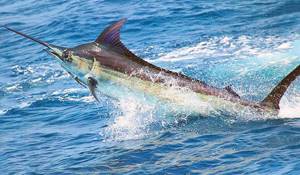
Photo: Marlin fish
Blue marlin are solitary fish that are known to undergo regular seasonal migrations, moving toward the equator during winter and summer. They feed on epipelagic fish including mackerel, sardines and anchovies. They may also feed on squid and small crustaceans when given the opportunity. Blue marlin are among the fastest fish in the ocean and use their beaks to fight their way through dense schools and return to feed on their dazed and wounded victims.
Black marlin are apex predators that feed primarily on small tuna, but also other fish, squid, cuttlefish, octopus and even large crustaceans. What is defined as a "smaller fish" is a relative term, especially when you consider that a large marlin weighing over 500 kg was found with a tuna weighing over 50 kg in its stomach.
Interesting Fact: Research off the east coast of Australia shows that black marlin catches increase during the full moon and week after their prey species move deeper from the surface layers, forcing the marlin to forage over a wider area.
White marlin feed near the surface during the day on a variety of fish, including mackerel, herring, dolphin and flying fish, as well as squid and crabs.
Striped marlin is a very powerful predator, feeding on a variety of small fish and aquatic animals such as mackerel, squid, sardines, anchovies, lancefish, sardines and tuna. They hunt in areas from the surface of the ocean to a depth of 100 meters. Unlike other species of marlin, striped marlin chops its prey with its bill rather than piercing it.
Marlin lifestyle
This fish is a ferocious predator that feeds exclusively on other fish (mainly mackerel - mackerel, tuna) and large squid. The weight of some victims reached 40 kg or even more). It leads a solitary lifestyle, only occasionally forming small flocks, and lives in the open sea far from the coast.
Such huge, fast fish have almost no natural enemies. Even sharks shy away from them, with the possible exception of the great white shark and mako shark, in whose stomachs the remains of Atlantic blue marlin are sometimes found.
Atlantic blue marlin is the most heat-loving fish among all marlin fish. It is found only in the Atlantic, in the range from 45°N. up to 35o S Moreover, in the cold months of the year it migrates closer to the equator.
Sexual maturity occurs at 2-4 years, when the weight of males reaches 35-44 kg, females - 47-61 kg. Reproduction lasts from late summer until autumn. In one season, females can spawn up to 4 times. The fish is very prolific and can lay up to 7 million eggs per season with an egg diameter of about 1 mm.
The eggs are pelagic (develop in the water column), so most of the eggs and larvae die. The larvae feed on zooplankton, planktonic eggs and larvae of other fish, and grow very quickly - up to 16 mm per day.
Why does a marlin need such a big spear? It turns out that while hunting, they crash into a school of fish and begin to swing them, which is why some of the fish are killed, injured or stunned. After this, the marlin calmly consumes its victims.
Features of character and lifestyle
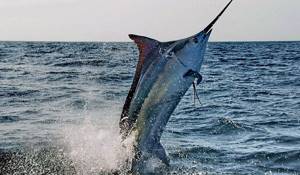
Photo: Blue Marlin
Marlin are aggressive, highly predatory fish that respond well to the splash and wake of well-presented artificial bait.
Fun Fact: Fishing for marlin is one of the most exciting challenges for any angler. Marlin is fast, he is athletic, and he can be very huge. Striped marlin is the second fastest fish in the world, swimming at speeds of up to 80 km/h. The speed of black and blue marlin also leaves most of the other fish that follow them behind.
Once hooked, marlin exhibit acrobatic abilities worthy of a ballerina—or perhaps it would be more accurate to compare them to a bull. They dance and leap through the air at the end of your line, giving the angler the fight of his life. It's no surprise that marlin fishing has an almost legendary status among anglers around the world.
Striped marlin is one of the most dominant fish species and has some interesting behavior patterns:
- these fish are solitary in nature and usually live alone;
- they form small groups during the spawning period;
- this species hunts during the day;
- they use their long beak for hunting and also for defensive purposes;
- these fish are often found swimming around bait balls (small fish swimming in compact spherical formations), causing them to get sucked in. They then swim through the bait ball at high speed, catching weaker prey.
Marlin in cooking

Marlin fish is very well known to culinary experts around the world. Moreover, they use it in different ways. Traditional Japanese sushi is often prepared using fish meat. In addition, it is ideal for preparing delicious, appetizing and nutritious first courses, as well as for grilling over coals.
Marlin fish is characterized by a relatively low percentage of fat content, and therefore it is highly recommended not to fry it too much. The most optimal cooking method from this point of view is grilling - only in this case the finished fish dish will have the necessary juiciness, tenderness and softness. In addition, pre-marinated marlin fish meat can be cooked over an open fire. Marlin fish fried in oil in a frying pan is no less tasty and nutritious.
One of the remarkable features of marlin fish is that its meat in its raw state has a reddish tint, which during heat treatment changes to a pinkish-fawn color. It is characterized by a fairly dense and elastic consistency, as well as a very pleasant taste. Due to the increased fat content, fish meat sometimes appears varnished or glazed.
Marlin fish contains a significant amount of useful substances - in particular, phosphorus, valuable omega-3 fatty acids, as well as some vitamins. Due to this, this fish is recommended to be consumed in order to protect against many diseases of the cardiovascular system. In addition, dishes prepared with this fish can significantly improve your mood and provide reliable protection against depression.
Many gourmets and cooks note that marlin fish has a lot in common with tuna. That is why these two types of fish can successfully replace each other when preparing some dishes - for example, sashimi.
Currently, several varieties of marlin fish are known. One of the most popular and widespread is the blue marlin, whose habitat is the waters of the world's oceans. This is a real giant, whose length can reach three meters. The second most popular is the striped marlin, which is characterized by a contrasting and expressive black and white color.
Video
Social structure and reproduction
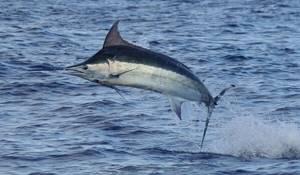
Photo: Atlantic Marlin
Blue marlin migrate frequently and therefore little is known about their spawning periods and behavior. However, they are very prolific, producing up to 500,000 eggs per spawning. They can live up to 20 years. Blue marlin spawn in the central Pacific Ocean and central Mexico. They prefer water temperatures between 20 and 25 degrees Celsius and spend most of their time near the surface of the water.
Known spawning areas for black marlin, based on the presence of larvae and juveniles, are limited to warmer tropical zones when water temperatures are around 27-28° Celsius. Spawning occurs at specific times in specific regions in the western and northern Pacific, in the Indian Ocean on the northwest shelf off Exmouth, and most widely in the Coral Sea off the Great Barrier Reef off Cairns during October and November. Here, suspected pre-spawning behavior was observed when "larger" females were followed by several smaller males. A female black marlin's egg count can exceed 40 million per fish.
Striped marlin reaches sexual maturity at the age of 2-3 years. Males mature earlier than females. Spawning occurs in summer. Striped marlin are multi-mating animals with females releasing eggs every few days, with 4–41 spawning events occurring during the spawning season. Females can produce up to 120 million eggs per spawning season. The spawning process of white marlin has not yet been studied in detail. What is known is that spawning occurs in the summer in deep ocean waters with high surface temperatures.
Reproduction and offspring
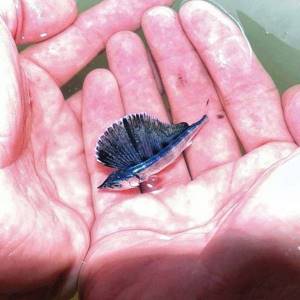
In the northern and southern hemispheres, small spearfish mature and begin spawning on similar calendar dates, which is clear evidence of the homogeneity of the entire population of this species. Female lesser spearfish spawn only once during the year.
Black marlin spawns at temperatures in the range of 27-28 ° C, and spawning dates can vary depending on the characteristics of the region. For example, in the waters of the South China Sea, fish begin spawning in May and June, and in the coastal zone of Taiwan, spawning of this species occurs from August to September. In the northwestern Coral Sea region the spawning period is October-December, and off the Queensland coastline it is August-November. Spawning is portioned, with the fertility of one individual up to forty million eggs.
Spawning of sailfish occurs from August to mid-September, in tropical warm and near-equatorial waters. This species is distinguished by small and non-sticky pelagic eggs, but adults do not take care of their offspring. All sailfish and related species of the family that lead a similar lifestyle are characterized by high fecundity, therefore, during one spawning season, the female lays several portions of about five million eggs.
The larval stage of marlin develops very quickly, and the average speed of growth processes under the most favorable external conditions is about fifteen millimeters within one day.
At the same time, a significant part of the offspring most often dies at the earliest stages of their development. The released eggs, larval stage and fry are used as food by numerous aquatic predators.
Natural enemies of marlins
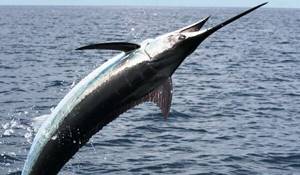
Photo: Big Marlin
Marlins have no other natural predators other than people who fish for them commercially. Some of the world's best marlin fishing occurs in the warm Pacific waters around Hawaii. There are probably more blue marlin caught here than anywhere else in the world, and some of the largest marlin ever recorded were caught on this island. The western town of Kona is known throughout the world for its marlin fishing, not only because of the frequency of big fish caught, but also because of the skill and experience of its top captains.
From late March through July, charter boats sailing from Cozumel and Cancun encounter masses of blue and white marlin, as well as other white fish such as sailfish that head into the warm waters of the Gulf Stream into the area. Blue marlin are generally smaller here than in the central Pacific. However, the smaller the fish, the more athletic it is, so the fisherman will still find himself in an exciting fight.
The first black marlin ever caught on rod and reel was caught by a Sydney doctor fishing from Port Stephens, New South Wales in 1913. Australia's east coast is now a mecca for marlin fishing, with blue and black marlin often caught on fishing charters in this area.
The Great Barrier Reef is the only confirmed breeding ground for black marlin, making eastern Australia one of the most popular black marlin fishing destinations in the world.
Striped marlin are traditionally the main whalefish species in New Zealand, although blue marlin are occasionally caught by anglers there. In fact, blue marlin catches in the Pacific Ocean have increased over the past ten years. Now they are constantly found in the bays of the islands. Waihau Bay and Runaway Point are particularly well known marlin fishing grounds.
Natural enemies
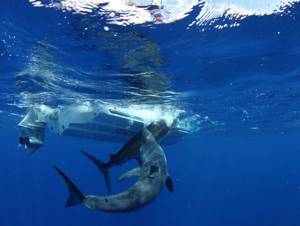
Atlantic blue marlin as well as blue marlin are susceptible to attacks by white sharks and mako sharks. In addition, experts were able to determine over a long period of observation that blue marlin suffer from many types of parasites (up to 3 dozen). Sticky fish quite often settle on the body of such fish, especially in the area of the gill covers.
Blue marlin, which are quite large in size, can attack equally large white marlin. And yet, it is believed that the main enemy of marlins is humans, since sailfish are of commercial interest. As a result of longline fishing, sailfish are caught in the nets along with fish such as tuna and swordfish.
Important fact! Off the coasts of many countries, local fishermen practice fishing for sailfish using spinning rods. This is a very interesting fishing that requires high skill and reliable gear.
Population and species status
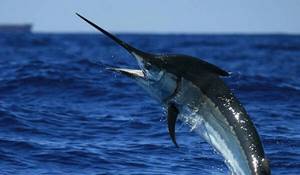
Photo: What marlin looks like
According to the 2021 assessment, Pacific blue marlin are not overfished. Population estimates for Pacific blue marlin are conducted by the Billfish Working Group, a division of the International Scientific Committee on Tuna and Tuna-Like Species in the North Pacific Ocean.
The prized white marlin is one of the most exploited fish in the open ocean. It is the subject of intense international restoration efforts. New research now shows that a similar species, the round billfish, makes up a relatively high proportion of fish identified as "white marlin." Thus, current biological information on white marlin is likely skewed by the second species, and past estimates of white marlin population size are currently uncertain.
Black marlin have not yet been assessed as to whether they are a threatened or endangered species. Their meat is sold chilled or frozen in the United States and prepared as sashimi in Japan. However, they are banned in some parts of Australia due to their high selenium and mercury content.
Striped marlin is listed in the Red Book and is a protected species of marlin. In Australia, striped marlin are caught throughout the east and west coasts and are a target species for anglers. Striped marlin is a species that prefers tropical, temperate and sometimes cold waters. Striped marlin are also occasionally caught recreationally off Queensland, New South Wales and Victoria. These recreational fisheries are managed by state governments.
Striped marlin is not included on the IUCN Red List of Threatened Species. However, Greenpeace International included these fish on its seafood red list in 2010, as their numbers are declining due to overfishing. Commercial fishing of this fish has become illegal in many regions. People who catch these fish recreationally are advised to put them back into the water rather than consume or sell them.
Marlin fishing
Marlin is known for its excitement and attacks the bait even when it is full. The main thing is to place the bait at depths accessible to the sailboat. It rarely rises to the very surface. You need to throw the bait about 50 meters. Blue marlin rarely bite here, but striped marlin are often hooked.
The method of catching marlin is called trolling. This is towing bait on a moving vessel. It should develop decent speed. A bait sluggishly floating behind a rowing boat rarely attracts the attention of a sailfish. In addition, catching the hero of the article from a simple rook is dangerous. “Bying” their noses into massive ships, marlins pierce ordinary wooden boats right through.
Trolling is reminiscent of spinning fishing, but the gear selected is as flexible and reliable as possible. The fishing line is taken strong. All these are attributes of trophy fishing, which includes trolling.
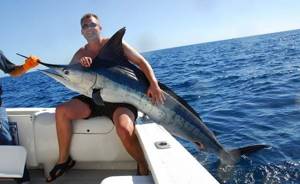
As bait, marlin accepts live fish such as tuna and mackerel, shellfish, and turtles. Of the artificial baits, sailfish accept wobblers. It is solid and voluminous.
The bite of different types of marlin is different. Striped fish actively jump out of the water, shaking the gear in one direction or the other. The description matches the data from the story “The Old Man and the Sea.”
If the main character came across a blue sailboat, he would jerk and move jerkily. Representatives of the black species prefer to go ahead of the boat and actively, evenly pull.
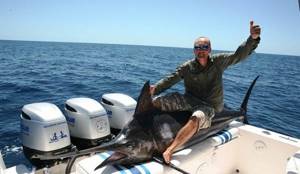
Due to their size, marlins “stand” at the top of the food chain. Man is the only enemy of adult fish. However, a young sailfish is a desirable prey, for example, for sharks. There have been cases when a marlin caught on a hook was swallowed even before being pulled to the boat. When catching a sailfish, fishermen received it in the womb of a shark.
Active marlin fishing has reduced their numbers. The animal is listed in the Red Book as a vulnerable species. This limited the commercial value of sailboats. In the 21st century they are just a trophy. He is pulled up to the boat, photographed and released.
Fishing places and habitat
As already mentioned, blue marlin is the most heat-loving species. The main habitat is in the western part of the Atlantic Ocean. In the eastern part it lives off the coast of Africa. Seasonal migrations, as a rule, are associated with changes in water temperature in the surface layer and the search for food objects. During cold periods, the range narrows and, conversely, expands in the summer seasons. The fish is in motion almost all the time. The range of transatlantic migrations of marlin is not entirely known, but fish tagged in American waters were later encountered off the coast of West Africa. The main habitat of western populations is within the Caribbean Sea and the northeastern shores of the South American continent.
Conservation measures
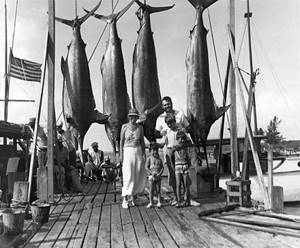
The main danger to the species is longline fishing. Japanese and Cuban fishermen catch thousands of tons of marlin every year in the Caribbean alone. The United States has passed a law requiring all vessels within 370 km of the coastline to release all marlin caught. However, the survival rate of released fish is low due to injuries caused during capture[11].
Due to overfishing, the International Union for Conservation of Nature has classified this species as Vulnerable.[5] In 2010, Greenpeace added it to its seafood red list, a list of species sold in supermarkets around the world that are at high risk of overfishing.[22]
Varieties and their differences
Like all fish, marlin has its own varieties, slightly different in the shape of the fin and the shade of the scales. Their hunting principles and lifestyle are similar, all species are also edible, and their meat is in special demand in restaurants in many countries .
- Black marlin is the giant of the family. The fins of the black type lack flexibility, the first dorsal fin is long with sharp rays, the second is located lower and smaller in size. The tail is sickle-shaped, with thin blades. The color is dark blue, closer to black, the belly is silver. The size of the giant allows it to descend to a depth of up to two kilometers with a temperature of 15 degrees.
- Striped marlin differs from its relatives not only in its specific color, but also in the size of its nose. A medium-sized fish reaches a mass of 500 kg, has fixed fins and a more varied color: the back is blue, streaked with light transverse lines, and they are blue on the silver belly.
- Blue marlin, or blue marlin, has the ability to change hue when hunting. The back is dark blue with characteristic stripes, the belly is silver, the fins are dark, high, flexible, tucked into a special compartment on the back.
All species are real racers; thanks to their specific body structure, they quickly pick up speed and maneuver easily; their type of swimming is similar to that of a shark.
Meaning for humans
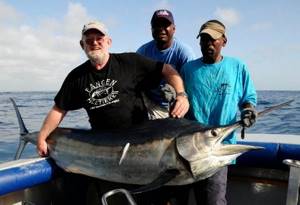
Black marlin fisheries occur primarily in the Indian Ocean. World catches in the 1970s–1990s ranged from 2.2 thousand to 6.4 thousand tons. The main countries involved in commercial fishing are Japan, Indonesia and Taiwan. They are caught using longlines, trolling and fishing gear[5].
It is a valuable hunting object among sport fishermen. Currently, fishermen release most of the marlin caught into the wild.
The meat is considered a delicacy and is prepared only in very expensive restaurants.
